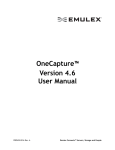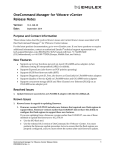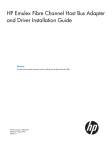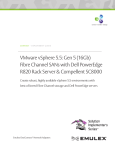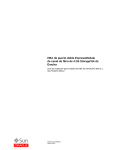Download User Manual
Transcript
OneCapture™
Version 10.3
User Manual
P010073-02A Rev. A
Emulex Connects™ Servers, Storage and People
2
Copyright © 2013-2014 Emulex. All rights reserved worldwide. No part of this document may be reproduced by any
means or translated to any electronic medium without the prior written consent of Emulex.
Information furnished by Emulex is believed to be accurate and reliable. However, no responsibility is assumed by
Emulex for its use; or for any infringements of patents or other rights of third parties which may result from its use. No
license is granted by implication or otherwise under any patent, copyright or related rights of Emulex.
Emulex, the Emulex logo, AutoPilot Installer, AutoPilot Manager, BlockGuard, Connectivity Continuum,
Convergenomics, Emulex Connect, Emulex Secure, EZPilot, FibreSpy, HBAnyware, InSpeed, LightPulse, MultiPulse,
OneCommand, OneConnect, OneCapture, One Network. One Company., SBOD, SLI, and VEngine are trademarks of
Emulex. All other brand or product names referenced herein are trademarks or registered trademarks of their
respective companies or organizations.
Emulex provides this manual “as is” without any warranty of any kind, either expressed or implied, including but not
limited to the implied warranties of merchantability or fitness for a particular purpose. Emulex may make
improvements and changes to the product described in this manual at any time and without any notice. Emulex
assumes no responsibility for its use, nor for any infringements of patents or other rights of third parties that may
result. Periodic changes are made to information contained herein; although these changes will be incorporated into
new editions of this manual, Emulex disclaims any undertaking to give notice of such changes.
Emulex, 3333 Susan Street
Costa Mesa, CA 92626
Note: References to OCe11100 series products also apply to OCe11100R series products.
OneCapture™ User Manual
P010073-02A Rev. A
Table of Contents
Table of Contents
1. Introduction .....................................................................................4
Abbreviations .......................................................................................... 4
2. Running OneCapture ..........................................................................5
Running OneCapture on Windows ................................................................. 5
Running OneCapture on Linux, Citrix, FreeBSD, and Solaris................................. 6
Command Line Interface Parameters .......................................................... 7
Running OneCapture on VMware ESXi ............................................................ 7
OneCapture for VMware ESXi with a Windows System ...................................... 7
OneCapture for VMware ESXi Locally .......................................................... 8
Command Line Interface Parameters .......................................................... 9
Silent Mode Execution.............................................................................. 10
3. Collected Data ................................................................................ 12
Windows Systems.................................................................................... 13
Linux Systems ........................................................................................ 15
Solaris Systems ...................................................................................... 19
FreeBSD Systems .................................................................................... 21
VMware Systems ..................................................................................... 22
4. Troubleshooting .............................................................................. 25
OneCapture™ User Manual
P010073-02A Rev. A
3
1. Introduction
Abbreviations
1. Introduction
OneCapture™ is an Emulex® device driver utility that gathers system, adapter, device
driver, and applications information. You can use this information to examine the
functionality of the drivers.
Data collected by OneCapture is compressed into a single file which can be sent to
Emulex Technical Support for analysis when debugging systems or for diagnostic
purposes.
OneCapture is fully supported on OCe11000-series adapters. For other models,
OneCapture can collect most data and basic dump data.
Abbreviations
ARP
address resolution protocol
CIM
Common Interface Model
CLI
command line interface
CPU
central processing unit
FC
Fibre Channel
FCoE
Fibre Channel over Ethernet
GUI
graphical user interface
HBA
host bus adapter
HTML
hyper-text markup language
IP
Internet Protocol
iSCSI
Internet Small Computer System Interface
NIC
network interface controller
OS
operating system
PCI
Peripheral Component Interconnect
SSH
Secure Shell
TCP
Transmission Control Protocol
UCNA
Universal Converged Network Adapter
RDMA
Remote Direct Memory Access
RoCE
RDMA over Converged Ethernet
OneCapture™ User Manual
P010073-02A Rev. A
4
2. Running OneCapture
Running OneCapture on Windows
2. Running OneCapture
You can run OneCapture on any of the following operating systems:
Windows
Linux
Citrix
FreeBSD
Solaris
VMware ESXi
OneCapture is installed as a single .exe or .sh file. Download the appropriate
OneCapture file to each of the machines from which you want to collect data. You can
run OneCapture from any directory or folder on your computer.
For Windows systems download the OneCapture.exe file.
For Linux, Citris, FreeBSD, and Solaris systems download the OneCapture.sh
file.
For ESXi systems:
Download the OneCapture_ESX.exe file to a remote Windows host. See
“OneCapture for VMware ESXi with a Windows System” on page 7 for
more information.
Download the OneCapture_ESX.sh to the ESXi host. See “OneCapture for
VMware ESXi Locally” on page 8 for more information.
Before OneCapture can run the .sh or .exe file, it must be uncompressed from
the tar or zip file.
Output is generated as HTML. Data may vary according to the system type in use.
Running OneCapture on Windows
For Windows systems, if the OneCommand Manager application was not installed
before running OneCapture, OneCapture will prompt you to install the basic ocmcore
service. The service is used during the dump procedure, and is removed after
execution.
If the OneCommand Manager application was not installed or allowed, only a
degraded capture is available.
Refer to the OneCommand Manager Application User Manual, available from the Emulex
website, for installation instructions.
To run OneCapture on Windows:
1. From Start Menu>Run, navigate to the folder in which OneCapture file was
downloaded, and run the OneCapture.exe or double-click the .exe file.
2. From the popup window, select where you want the OneCapture output file stored.
You can leave the default path or specify a different one.
3. From the drop-down menu, select the level of capture type you want to use. You
can select 'Basic', 'Safe', 'Full' or 'Custom'.
OneCapture™ User Manual
P010073-02A Rev. A
5
2. Running OneCapture
Running OneCapture on Linux, Citrix, FreeBSD, and Solaris
Basic – The default selection. Select Basic if you do not need to use another type
of capture.
Safe – Use Safe if you are capturing data on a Boot from SAN system.
Full – Includes all available captures, but requires a system and adapter reboot.
Use only if needed.
Custom – Automatically selected when you do a custom pick of components to
capture in the checkbox list.
4. Click Capture. OneCapture gathers the needed information and outputs the file to
the specified folder.
5. After OneCapture is finished running, click Finish on the popup window to close
OneCapture and view the results.
Running OneCapture on Linux, Citrix, FreeBSD, and
Solaris
For Linux, Citrix and Solaris systems, if the OneCommand Manager application was
not installed before running OneCapture, OneCapture will prompt you to install the
basic ocmcore service (OneCapture_Linux_ocmcore.sh). The service is used during the
dump procedure, and is removed after execution.
If the OneCommand Manager application was not installed or allowed, only a
degraded capture is available.
Refer to the OneCommand Manager Application User Manual, available from the Emulex
website, for installation instructions.
Two distributions are included for Linux, Citrix, and Solaris OneCapture.
OneCapture_Linux_10.0.623.0.tgz (OneCapture_Linux.sh)
OneCapture_Linux_ocmcore_10.0.623.0.tgz (OneCapture_Linux_ocmcore.sh)
or
OneCapture_Solaris_10.0.623.0.tgz (OneCapture_Solaris.sh)
OneCapture_Solaris_ocmcore_10.0.623.0.tgz
(OneCapture_Solaris_ocmcore.sh)
One is the general executable file and the other is the ocmcore service embedded
executable file.
Use OneCapture_FreeBSD.sh for FreeBSD systems.
Note: FreeBSD systems do not support the OneCommand Manager application,
therefore OneCapture does not collect the OneCommand Manager application
related data, but OneCapture can collect firmware core dumps.
To run OneCapture on Linux, Citrix, FreeBSD, and Solaris:
1. Copy the script file onto the system through SSH (Secure Shell) or use any other
method.
2. Run the shell script for corresponding systems, for example:
./OneCapture_Linux_ocmcore.sh
OneCapture™ User Manual
P010073-02A Rev. A
6
2. Running OneCapture
Running OneCapture on VMware ESXi
3. Change the script to executable mode, for example, Chmod 777 OneCapture.
The progress of the script is displayed. For example:
Running Emulex OneCapture Solaris, version
Emulex Corporation Report Utility
Started at Friday, February
1, 2013 12:50:42 PM CST
Initializing report environment for host:solaris
Collecting System Information...
[-]
1%
uname -a
4. After the OneCapture script finishes gathering information it creates a zipped
tarball file in its current working directory. Open that file to view the information.
Command Line Interface Parameters
The following are the available CLI parameters.
-h|--help
Displays a brief guide on command usage and supported parameters.
--deaddump
Collects the dead firmware dump data.
Note: This command causes system instability if the adapter is the boot device.
--bootfromsan
Skips collecting firmware dump files for all adapters.
Note: You must use this command if the adapter is the boot device in a boot from
SAN configuration.
Running OneCapture on VMware ESXi
OneCapture for VMware ESXi with a Windows System
Before running OneCapture on VMware ESXi with a Windows system:
The Windows system must have network access to the ESXi system being
captured. Ensure the firewall rules and network configurations are correct.
The Windows system can be a guest OS in a virtual machine.
For VMware systems, the Emulex CIM Provider must be installed before
running OneCapture. If the Emulex CIM Provider was not installed before
running OneCapture, OneCapture will prompt you to install the CIM Provider.
The CIM Provider is used during the dump procedure, and is removed after
OneCapture™ User Manual
P010073-02A Rev. A
7
2. Running OneCapture
Running OneCapture on VMware ESXi
execution. Refer to the Emulex CIM Provider Package Installation Guide, available
on the Emulex website, for instructions.
You must enable SSH access on the ESXi system.
To enable SSH on the ESXi system:
1. Press F2 on the ESXi main screen.
2. Go to Troubleshooting Options.
3. Choose Enable SSH.
Note: Ensure that the user name and password do not include these special
characters: !@#$%^&*()_+{|:"<>?. These special characters are not supported.
To run OneCapture:
1. From the Windows system run the OneCapture.exe file either through the
Start>Run window or by double-clicking the .exe icon.
2. On the popup window, specify the directory where you want the OneCapture file
to reside. By default, this path is set to
C:\Users\<yourname>\Documents\Emulex\OneCapture
3. Specify the IP address, Username, and Password of the ESX server from which you
want to capture data.
4. Specify the ESXi Connection Information. Both SSH and CIM use the same
credential for the ESXi system.
5. Click Capture.
6. From the drop-down menu, select the level of capture type you want to use. You
can select 'Basic', 'Safe', 'Full' or 'Custom'.
Basic – The default selection. Select Basic if you do not need to use another type
of capture.
ESXi 5.5 Capture - removes proc pages which no longer exist on ESXi 5.5
Safe – Use Safe if you are capturing data on a Boot from SAN system.
Full – Includes all available captures, but results in a system and adapter reboot.
Use only if needed.
Custom – Automatically selected when you do a custom pick of components to
capture in the checkbox list.
7. Click Capture.
After OneCapture collects the data, it generates a zipped file in the default directory
or one that you specified. Open that file to view the information.
OneCapture for VMware ESXi Locally
Before obtaining a OneCapture on VMware ESXi locally:
For VMware systems, the Emulex CIM Provider must be installed before
running OneCapture. If the Emulex CIM Provider is not installed before
running OneCapture, OneCapture cannot collect complete system information;
such as adapter core dumps.
You must enable the ESXi shell.
OneCapture™ User Manual
P010073-02A Rev. A
8
2. Running OneCapture
Running OneCapture on VMware ESXi
To enable the ESXi shell:
1. Press F2 on the ESXi main screen.
2. Go to Troubleshooting Options.
3. Choose Enable ESXi shell.
You may also run the "OneCapture_ESX.sh" by SSH to the ESXi host.
To run OneCapture:
1. Copy the script file "OneCapture_ESX.sh" onto the system through SSH (Secure
Shell) or use any other method.
2. Run the shell script for corresponding systems, for example:
./OneCapture_ESX.sh
3. Change the script to executable mode, for example, Chmod 777 OneCapture. The
progress of the script is displayed. For example:
Verifying archive integrity... All good.
Uncompressing Emulex OneCapture ESX.....
Emulex OneCapture ESXi, version 10.3.96.0
Emulex Corporation Report Utility
Started at Mon Dec 13 08:53:58 UTC 2013
Initializing report environment for host:esxi55-sandbox.emulex.com
Collecting System Information...
Obtaining vm-support...
[\]
4. After the OneCapture script finishes gathering information it creates a zipped
tarball file in its current working directory. Open that file to view the information.
Command Line Interface Parameters
The following are the available CLI parameters for ESXi.
-h|--help
Displays a brief guide on command usage and supported parameters.
--deaddump
Collects the dead firmware dump data.
Note:
This command causes system instability if the adapter is the boot device.
--bootfromsan
Skips collecting firmware dump files for all adapters.
Note: You must use this command if the adapter is the boot device in a boot from
SAN configuration.
OneCapture™ User Manual
P010073-02A Rev. A
9
2. Running OneCapture
Silent Mode Execution
Silent Mode Execution
To run OneCapture with the GUI in Windows and ESXi in silent mode, without user
input, use the following command line parameters.
For Windows and ESXi systems:
Usage example:
OneCapture.exe /silent /type=basic /dir=”C:\Capture\BE3”
/outputfilename "output.zip"
Available parameters:
/force
Forces a capture without showing any prompts.
/silent, /verysilent
/silent must be used for silent mode, /verysilent is for not displaying the progress
windows.
/skip_ocm
Does not use the Emulex OCM service to get driver related information and dump files.
When used without this option in silent mode, OneCapture OCM related information is
captured by default.
/dir=”x:\dirname”
Overrides the default directory in the select output path. It can be omitted if default
path is used.
/outputfilename "output.zip"
Specifies the OneCapture output file name.
/type=type name
Chooses the capture type which currently includes “Basic”, “Safe”, “Full”, and
“Custom”.
/h
To see Help information. The available types and available components are listed.
For ESXi systems only:
Usage example:
OneCapture™ User Manual
P010073-02A Rev. A
10
2. Running OneCapture
Silent Mode Execution
OneCapture_ESX.exe /silent /type=basic /dir="C:\Capture\BE3" /connect
[ip address] /username [username] /password [password] /skip_cim
Available parameters:
/connect [ip address]
Sets the remote VMware host IP address to which to connect.
/username [username]
Sets the remote VMware host username to which to connect.
/password
[password]
Sets the remote VMware host password to which to connect.
/skip_cim
This option forces OneCapture to not check whether the CIM provider is installed on
the remote VMware host.
OneCapture™ User Manual
P010073-02A Rev. A
11
3. Collected Data
Silent Mode Execution
3. Collected Data
OneCapture by default collects live firmware core dumps. For dead dumps, Emulex
adapters are taken offline during OneCapture execution. You must reboot to bring the
adapters online.
To skip collect FW dumps:
For Linux and Solaris systems, use "--bootfromsan'' to skip live dumps.
For Windows and VMware systems, choose "safe" mode, or uncheck dump
options in GUI interface, or use the "/type=safe" for the "/component" option to
choose the necessary items.
To collect dead dumps:
For Linux and Solaris systems, use "--deaddump".
For Windows and VMware systems, choose "full" mode, or select options in
GUI interface. Use the "/type=full" for the "/component" option to choose the
necessary items in CLI interface.
OneCapture cannot collect data for certain non-default library commands. However,
you can install add-on packages for those commands if the packages are compatible
with your system.
Below is a list of packages that may not be included with default installations. Install
these packages to capture the most data.
Note: OneCapture packet data may be captured as part of the memory dump within
the firmware dump.
For Linux
sysstat – to utilize iostat mpstat
hwinfo – to utilize hwinfo
sg3_utils – to utilize sg_map
dmidecode – to utilize dmidecode, biosdecode
smbios-utils – to utilize smbios
netstat-nat – to utilize netstat
libblkid – to utilize blkid
procps – to utilize vmstat
device-mapper-multipath – to utilize multipath
bridge-utils – to utilize brctl
libvirt-utils – to utilize virsh
For Solaris and FreeBSD
pciconf – to utilize pciconf
prtdiag – to utilize prtdiags
The following tables describe, by operating system, the information that is collected by
OneCapture.
OneCapture™ User Manual
P010073-02A Rev. A
12
3. Collected Data
Windows Systems
Windows Systems
The following information is available for Windows systems.
Table 3-1 Windows information collected
Type
Information
System Configuration
System information
System inventory
PCI information
CPU information
CPUEx information
Driver Configuration
PnPutil information
<HKLM>/Hardware/DeviceMap/Scsi
NIC
NIC occfg information
becfg4 output
becfg6 output
registry parameter value
driver parameter value
adapters registry value
CPU topology
IP information
NIC tcpglobal information
NIC tcp offload information
NIC SEstats parameters
NIC tinylog
iSCSI
iSCSI information
iSCSI target information
iSCSI diskpark details
iSCSI SEstats information
iSCSI registry information
RoCE
TinyLogCM
OneCapture™ User Manual
P010073-02A Rev. A
13
3. Collected Data
Windows Systems
Table 3-1 Windows information collected (Continued)
Type
Information
TinyLog
PowerShell RoCE Information
SEstats RoCE information
NetStat RoCE information
ElxTrace
Trace messages
MILI
MILI log
MILI service status
Hbacmd MILIReport
OneCommand Manager
Application Information
Hbacmd version
Hbacmd ListHBAs
Hbacmd ListHBAs (local)
Hbacmd HbaAttribute (local)
Hbacmd PortAttribute (local)
Cnaboardmgmt.log
RM.log
OneCommand Manager installer log
HBA Core Dump
Core dump (hbacmd dump)
Core dump down (hbacmd dump down)
Windows Information
Emulex services status
setupapi.*.log
Event logs
Autopilot Information
AutoPilotReport
FC
FCoE
iSCSI
NIC
OneCapture™ User Manual
P010073-02A Rev. A
14
3. Collected Data
Linux Systems
Table 3-1 Windows information collected (Continued)
Type
Information
AutoPilot Configuration
Data
FC
FCoE
iSCSI
NIC
MPIO Information
mpclaim -s
mpclaim -e
mpclaim -v
Linux Systems
The following information is available from Linux systems.
Table 3-2 Linux information collected
Type
Information
Parameter
System Information
Kernel version
Distributed version
Kernel modules currently loaded
lsmod
Kernel memory allocations
numastat
Running processes
ps
Running tasks
top
Processors statistics
mpstat
Memory statistics
free
Installed packages
rpm -qa
System hardware description through
SMBIOS/DMI
dmidecode
Hardware Information
PCI Information
Tree diagram containing all buses,
bridges, devices, and connections
Verbose and detailed information plus
PCI configuration space dump on
devices with Emulex vendor ID
OneCapture™ User Manual
P010073-02A Rev. A
15
3. Collected Data
Linux Systems
Table 3-2 Linux information collected (Continued)
Type
Information
Parameter
CPU structures
/proc/cpuinfo
Memory structures
/proc/meminfo
Kernel version
/proc/version
System uptime
/proc/uptime
Kernel boot parameters
/proc/cmdline
System memory mapping
/proc/iomem
Memory zones and virtual memory
/proc/zoneinfo
Devices group
/proc/partitions
Kernel caches
/proc/slabinfo
Network device status
/proc/net/dev
SCSI devices
/proc/scsi/scsi
Network interfaces information
ifconfig -a
Kernel Information
NIC Information
NIC driver parameters
Firewall configurations
iptables
NIC related packages information
Kernel Runtime
Parameters
List of all kernel runtime parameters
Network Statistics
Summary statistics for each protocol
Table of all available network interfaces
All current TCP connections
Routing table
Virtual Memory Statistics
Various event counters and memory
statistics
Disk statistics
slabinfo
Device Interrupts
Emulex device interrupts counter, in
five-second intervals
iSCSI Specific Information
OneCapture™ User Manual
P010073-02A Rev. A
16
3. Collected Data
Linux Systems
Table 3-2 Linux information collected (Continued)
Type
Information
Parameter
Current multipath topology
multipath -ll
iSCSI module information
modinfo be2iscsi
Partition tables
File system mount
Disk UUID
Disk space available
File system table
/etc/fstab
SCSI information
Mount information
FC Specific Information
modinfo
SCSI device info
SCSI class information
FCoE Specific Information
lpcs driver information
SCSI class information
/sys/class/scsi/..
lpfcmlp information
/proc/scsi/lpfcmpl/*
Library Information
The version number for the following
libraries:
• libdfc
• libmili
• libHBA
• libemulexhbaapi
Driver Information
RPM packages with be2 prefix name
Loaded kernel modules with be2 prefix
name
NIC kernel module information
modinfo be2net
lpfc kernel module information
modinfo lpfc
OneCommand Manager
Application Information
RPM packages with elx prefix name
Running status of process hbanywhere
Running status of process ocmanager
OneCapture™ User Manual
P010073-02A Rev. A
17
3. Collected Data
Linux Systems
Table 3-2 Linux information collected (Continued)
Type
Information
Parameter
List of executable files with elx prefix
name
List of executable files with mili prefix
name
rm.log
cnaboardmgnt.log
utils-install.log
mili2d.log
Installer.log
HBACMD
listhbas
milirpt
version
hbaattr (local HBA only)
Kernel Log
dmesg kernel log
Kernel Configuration
Compile time kernel configuration
/proc/config.gz
xinetd configuration, network services
daemon configuration
Module loading configuration
/proc/modprobe.conf
Core Dump
hbacmd dump
hbacmd dump down
Crashdump
dump
/CrashDump/
multipath -ll
/etc/multipath.conf
MPIO Info
Virtualization Logs
/var/log/xen/xend.log
/var/log/libvirt/libvirtd.log
OneCapture™ User Manual
P010073-02A Rev. A
18
3. Collected Data
Solaris Systems
Solaris Systems
The following information is available from Solaris systems.
Table 3-3 Solaris information collected
Type
Information
Parameter
Kernel version
uname -a
Network interface
ifconfig -a
Processors info
psrinfo -pv
Swap info
swap -s
Last reboot time
last reboot
Uptime
uptime
Running tasks
top -d 5 -n 2
Running processes
ps -ef)
Loaded modules
modinfo
Service status
svcs
Device status
cfgadm -al
BIOS information
smbios
PCI buses info
scanpci
System peripherals info
prtconf -v
System peripherals tree
prtconf -vp
Host HBA info
fcinfo hba-port
Network interface
ifconfig -a
IP filter rule
/etc/ipf/ipf.conf
Per-protocol statistics
netstat -s
ARP tables
netstat -p
All TCP statistics
netstat -aP tcp
Routing tables
netstat -rn
Multicast memberships
netstat -g
INET family streams stats
netstat -idm -f inet
System events since boot
vmsat -s
System Information
Hardware Information
NIC Specific Information
Network Statistics
System Statistics
OneCapture™ User Manual
P010073-02A Rev. A
19
3. Collected Data
Solaris Systems
Table 3-3 Solaris information collected (Continued)
Type
Information
Parameter
Paging Activity in 5 seconds
vmstat -p 1 5
Device Interrupts
Emulex device interrupts counter, 5
seconds
Kernel Parameters
System definition
sysdef -D
System definition, in device tree format
sysdef -dD
Kernel statistics
kstat
OneCommand Manager
Application Information
Running status of process hbanywhere
Running status of process ocmanager
List of executables with elx prefix name
List of executables with mili prefix
name
rm.log
cnaboardmgnt.log
utils-install.log
mili2d.log
installer.log
HBACMD
listhbas
milirpt
version
hbaattr (local only)
portattr (local only)
Kernel Log
dmesg kernel log
Kernel Configuration
System parameters
/etc/system)
Kernel symbols
nm -x /dev/ksysm | grep OBJ
Core Dump
hbacmd dump
hbacmd dump down
OneCapture™ User Manual
P010073-02A Rev. A
20
3. Collected Data
FreeBSD Systems
Table 3-3 Solaris information collected (Continued)
Type
Information
Parameter
dump
/CrashDump/
Crash Dump
FreeBSD Systems
The following information is available from FreeBSD systems.
Table 3-4 FreeBSD information collected
Type
Information
Parameter
Kernel information
uname -a
Kernel release
uname -r
Network interfaces
ifconfig -a
Hardware model
sysctl -a | egrep -I hw.model
Clockrate
sysctl -a | egrep hw.clockrate
CPU Count
sysctl -a | egrep hw.ncpu
Boot time
sysctl -a | grep boottime
Running tasks
top -d 5 -n 2
Running processes
ps -ef
Kernel modules
kldstat
System hardware description through
DMI
dmidecode
PCI devices list with capabilities
supported with vendor device
information
pciconf -l -cv
Interfaces info
ifconfig ifx
OneConnect info
sysctl -a | grep dev.oce
IP Firewall
ipfw list
OneConnect package
pkg_info |grep oce-
List of all kernel runtime parameters
sysctl -a
System Information
Hardware Information
PCI Information
NIC Information
Kernel Runtime
Parameters
OneCapture™ User Manual
P010073-02A Rev. A
21
3. Collected Data
VMware Systems
Table 3-4 FreeBSD information collected (Continued)
Type
Information
Parameter
TCP send buffer size
sysctl -a | grep wmem
Per-protocol statistics
netstat -s
All Interfaces state
netstat -i
All TCP statistics
netstat -aP tcp
Routing tables
netstat -rn
INET family Streams Stats
netstat -idb -f inet
Various event counters and memory
statistics
vmstat -s
slabinfo
vmstat -m
Netstat Information
Virtual Memory Statistics
Device Interrupts
Emulex device interrupts counter, in 5
seconds interval
Log
Installer Log
Kernel Log
All /var/log/messages* files
Kernel Configuration
Kernel Compile configuration
(/usr/src/sys/i386/conf/GENERIC)
Kernel Bootstrap configuration
/boot/defaults/loader.conf
dump
/CrashDump/
dump
dump/CoreDump
Crash Dump
Core Dump
VMware Systems
The following information is available from VMware systems.
Table 3-5 VMware information collected
Type
Information
VMware vm-support
package (as provided by
default manifest in ESXi)
Active directory
OneCapture™ User Manual
P010073-02A Rev. A
22
3. Collected Data
VMware Systems
Table 3-5 VMware information collected (Continued)
Type
Information
CIM
Configuration
Crash
Fault
File system
Hardware
Hung VM
Installer
Integrity checks
Logs
Network
Performance snapshot
Storage
System
Testing
Userworld
Virtual
Host profiles
SCSI /proc/lpfc820 dump
(ESXi 5.0 and 5.1 systems
only)
Debug pages from lpfc device driver
HBA Dump
Core dump
HBACMD
(ESXi 5.0 and 5.1 systems
only)
HBA list (all under management)
HBA attributes
HBA list (local)
Port attributes
MILI log
RM.log
mili2d.log
OneCapture™ User Manual
P010073-02A Rev. A
23
3. Collected Data
VMware Systems
Table 3-5 VMware information collected (Continued)
Type
Information
Log config
/tmp/*.log
/tmp/ucna.txt
/etc/cim/emulex/*.log
/etc/cim/emulex/*.dmp
/etc/cim/emulex/*.conf
VM_KV_PAGE
vm_kv_page -v
lpfc-kv-pages.txt
vm_kv_page -q all -p all
lpfc-kv-pages.txt
OneCapture™ User Manual
P010073-02A Rev. A
24
4. Troubleshooting
VMware Systems
4. Troubleshooting
There are several circumstances in which your system may operate in an unexpected
manner. The Troubleshooting section explains many of these circumstances and offers
one or more workarounds for each situation.
Note: If no operating system is specified, then the issue is applicable to all operating
systems.
Table 4-1 OneCapture troubleshooting
Situation
Resolution
UCNA information was not captured. You must install OneCapture on the system where you are
collecting data. Install the OneCommand Manager application
from the Emulex website. Additionally, install the driver for the
devices on the system. The drivers must be installed before
driver information is available for capture.
The output HTML file displays a
“missing Data File” error.
Ensure that the zipped file has been extracted completely from
the archive folder before you open the HTML file.
Cannot connect although the user
name and password are correct.
Access through OneCapture VMware
ESXi is denied. (VMware systems
only)
Due to the nature of command line processing, OneCapture
cannot handle the parameter when it includes these special
characters: ~!@#$%^&*()_+{}|:"<>?[]\;',./ .
After connecting, the OneCapture
VMware script displays an “Emulex
CIM-provider” warning. (VMware
systems only)
Install the Emulex CIM Provider on the VMware ESXi system. You
can download it from the Emulex website.
Make sure that the username and password do not include any of
these special characters, and try again.
By default, OneCapture only collects If you select dead dumps for OCe11102 or OCe14000 series
live firmware dump data. If you
adapters, the adapters are taken offline and require a system
manually choose dead dump
reboot to recover.
collection, the dump procedure
temporarily takes the adapter
offline.
OneCapture™ User Manual
P010073-02A Rev. A
25


























